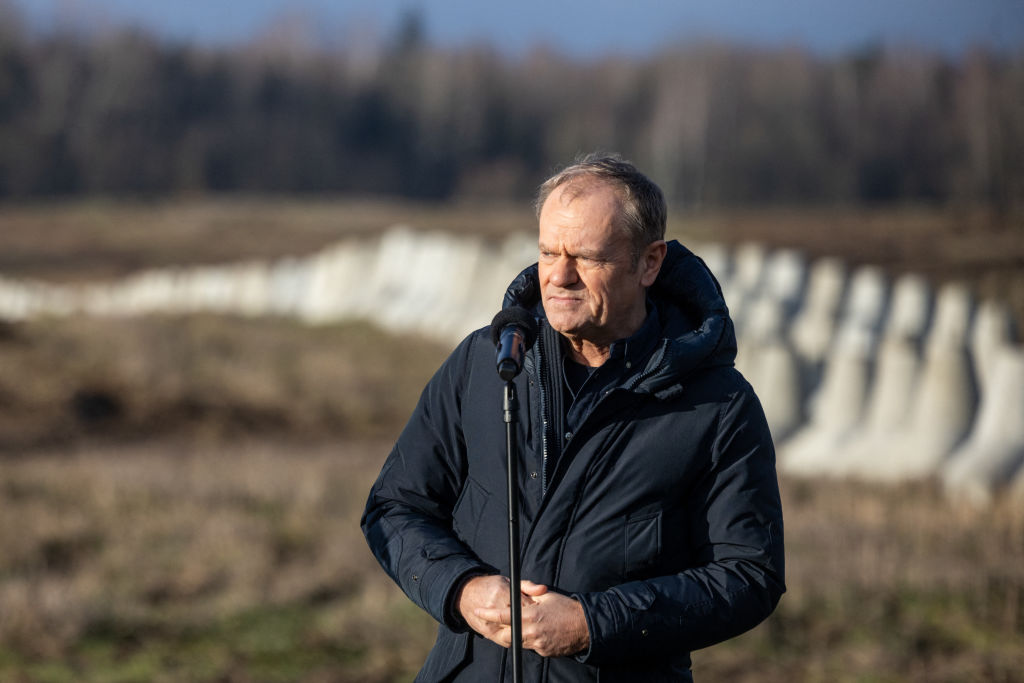A ceasefire in Ukraine is far from being agreed, yet Poland is already preparing for its collapse. In recent months, Warsaw has been digging an anti-tank ditch along its border with Russia and Belarus – and has decided to extend it to Ukraine. The 400-mile-long ‘East Shield’ will almost double in size and include minefields and bunkers, anti-drone systems and AI-powered defences to protect Poland from possible invasion. Ukraine’s closest neighbour clearly puts little trust in Donald Trump’s promise of peace with Russia: if Vladimir Putin rearms and comes back for more, Poland must be ready to meet battle-hardened Russian troops at its border.
Donald Tusk called the £2.5 billion project an ‘investment in peace’ to deter and discourage any possible aggressor. The Polish Prime Minister explained the need to extend the barricade to Ukraine as a way for Poles ‘to feel safer along the entire eastern border’. Warsaw understands that Ukraine’s security is pivotal for Poland’s security; it has been aiding Kyiv with heavy armour since the early days of the full-scale war, supplying tanks – more than 300 now – when others sent helmets. These efforts could soon be undermined by a rushed peace deal: Donald Trump wants to be lauded as a ‘peacemaker’ as soon as possible, without understanding how to make the armistice last. Tusk insists that Poland, as a ‘front line country’, must have a voice in Trump’s peace efforts. Decisions on the war, he declared recently, cannot be made ‘over the heads of Ukrainians – or ours’.
The leading idea behind Trump’s ‘security guarantee’ for Ukraine – deploying thousands of European troops to guard the 700-mile front line for years – is hardly a viable solution. General Viktor Muzhenko, Ukraine’s former army chief, warns that such a plan is not only difficult to execute but could also lead to disaster: ‘It is extremely dangerous that more than a million people with a vast array of weapons will be stationed on both sides of this line. Where is the guarantee that there won’t be accidental shots, triggering some kind of reaction?’. Russian and Ukrainian soldiers kept exchanging fire after the Minsk-1 and Minsk-2 ‘ceasefires’. Caskets kept arriving from the front line for eight years. What happens if a Nato soldier is killed in Ukraine?
Nato’s eastern flank is growing anxious about whether America will leave it to fend for itself if Moscow attacks. Trump threatened to let Russia ‘do whatever the hell they want’ to any Nato country which fails to meet defence spending guidelines (at least 2 per cent of GDP). Poland is leading the charge with double that figure, and the Baltic states are among the top spenders, but Trump’s recent statements must make them wonder whether Washington will come to the rescue if the conflict with Russia evolves.
Putin arrived in Belarus earlier today to sign a treaty on mutual security guarantees, which states that any weapon, including nuclear, can be used for defence. Alexander Lukashenko said he was ‘worried’ about the situation on the border with Poland and Lithuania because, he claims, Nato troops are gathering forces there. He asked Putin to deploy medium-range Oreshnik missiles to Belarus and grant Minsk the authority to choose its own targets. Putin replied that this would be possible in the second half of next year. This spectacle repeated last year’s deployment of Russian nuclear warheads to Belarus, aiming to inspire fear and warn the West against supporting Ukraine. Even the Oreshnik strike on Dnipro last month turned out to be a PR stunt designed to ‘scare Europeans into submission’, according to Russian officials.
In the past year, the Kremlin has launched dozens of sabotage campaigns in Europe, from cyber-attacks to assassinations. The Baltic states take Moscow’s actions seriously, jointly reinforcing their air defences, armies and borders with Russia. Ukraine once envisioned its own wall with Russia. Construction began after the 2014 invasion, but Kyiv lacked the funds – and time – to build the fortifications properly, while several contractors and border guards faced arrests for embezzlement. The fence failed to stop Russian tanks in February 2022.
Kateryna Stepanenko, an analyst at the Institute for the Study of War, tells me the calculus behind Putin’s invasion has been not only to ensure that Ukraine remains under Russia’s sphere of influence, but also to break the Nato apart. ‘He wants to prove to the international community that Nato is just a paper tiger, that it is not going to live up to its promises and won’t be able to organise a collective response even if there is a significant threat,’ Stepanenko says. ‘Putin rose to power with the anti-Nato, anti-western grievance and must sustain it to keep Russians supporting him.’ Ukraine’s neighbours are right to spend heavily on defence, preparing for the worst – if Europe wants real peace, every country must do the same.








Comments